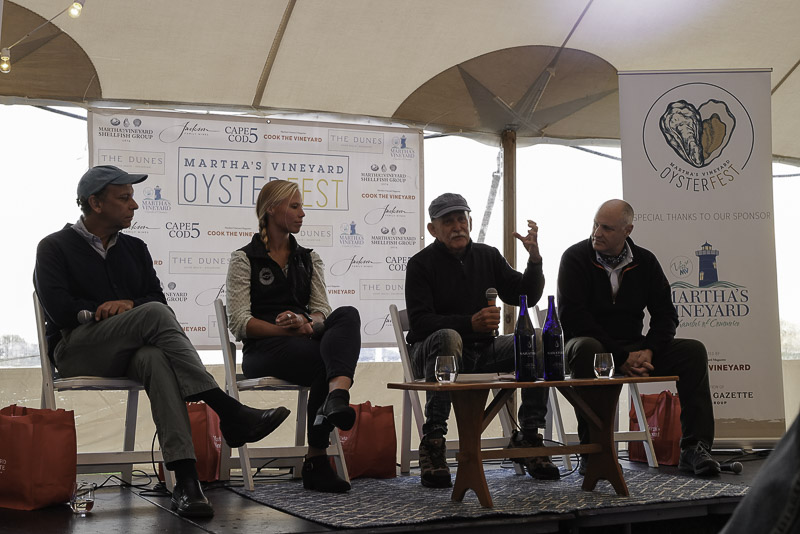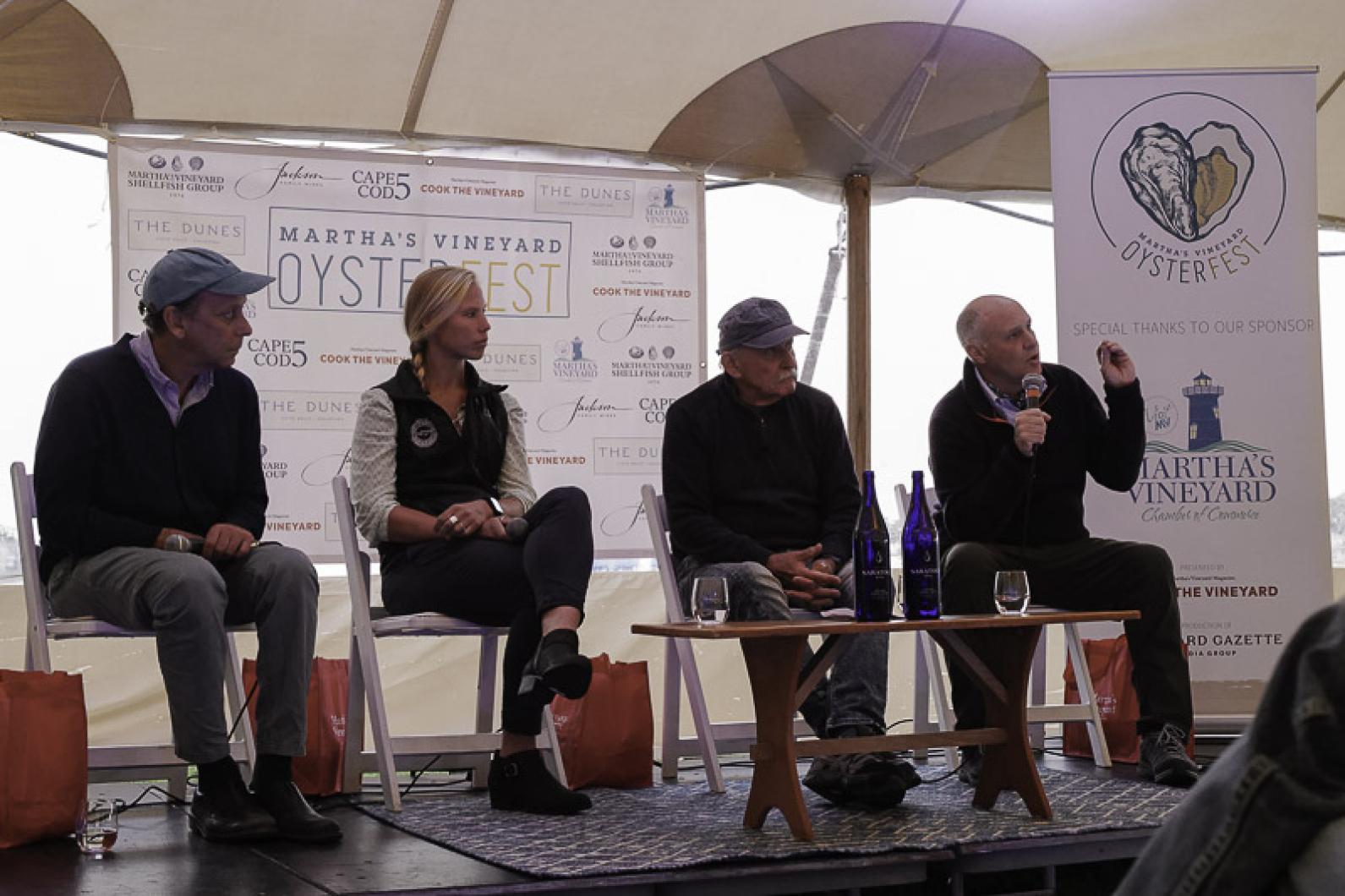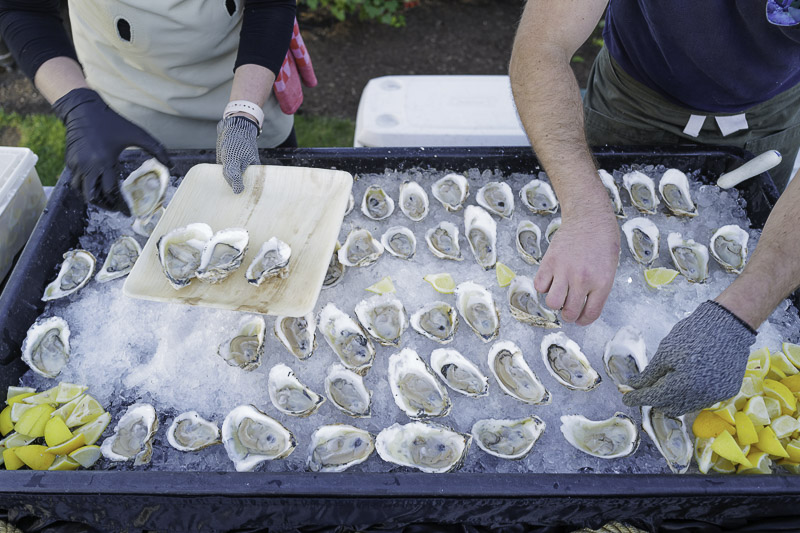Prized for their briny flavor, oysters are proving to be far more than an upscale menu item — they’re a nutritional and ecological superhero in waiting, with the potential to help save the environment and feed the world, according to an expert panel at the Martha’s Vineyard Museum Friday night.
“They’re really marvelous creatures, on so many levels,” said shellfish biologist Rick Karney, founder and executive director emeritus of the Martha’s Vineyard Shellfish Group, who began his career nearly 50 years ago.
“Back then, we basically grew shellfish to eat,” Mr. Karney told the audience at the sold-out Martha’s Vineyard Oyster Festival.
“Over the years, different things would come up . . . health issues with high blood pressure, with cholesterol, with cancer, with all these other things and lo and behold, shellfish are like this miraculous health food. They have all these different vitamins and nutrients,” he said.
“Obviously I’m biased, but it seems like shellfish are like this panacea for all these issues.”
Oysters are high in protein, making them an efficient food source, and they also play a role in cleaning pond water that’s polluted with algal blooms from excess nitrogen, Mr. Karney said.
“They filter water at an incredible rate, and they eat the algae that’s growing . . . another solution to another problem, at least part of it.”
Sponsored by the Vineyard Gazette and Cook the Vineyard, the panel discussion kicked off a weekend of tastings and educational events at the hilltop museum campus in Vineyard Haven.

Friday’s panel also included Harriet Booth, marine resource specialist for Woods Hole Sea Grant and Cape Cod Cooperative Extension, and Paul Dobbins, senior director of impact investing and ecosystems services on the World Wildlife Fund’s aquaculture team.
Author and seasonal Island resident Paul Greenberg, a James Beard Award winner for his book Four Fish: The Future of the Last Wild Food, moderated the discussion, which roamed from Mr. Karney’s accidental career in shellfish to Mr. Dobbins’s global economic view and Ms. Booth’s recent work with regional oyster farmers whose business nosedived in the pandemic.
“Ninety-five per cent of oyster production goes to the raw half-shell market [restaurants and raw bars],” she said. “With restaurants shutting down, growers had nowhere to sell. There was basically a stop in cash flow.”
Meanwhile, unharvested oysters grew larger and larger, outstripping the preferred size for raw dining and taking up space needed for new seed.
“It was a really big issue,” Ms. Booth said, estimating that oyster farmers took an 80 per cent to 90 per cent loss.
Federal rapid-response funds through Sea Grant paid for processing more than 75,000 big oysters from 76 growers, she said, with the shucked oysters donated through the Greater Boston Food Bank. “We were able to donate about 1,800 pounds,” Ms. Booth said.
Bridging the gap between food banks and high-end menus by bringing down prices to everyday-grocery levels, would require more oyster farms — something that’s still out of the ordinary in American waterways, Mr. Dobbins said.
“Our waters are busy — they’re really busy — and we don’t have a history of doing this, so it’s very, very difficult for farmers in the U.S. to get permission to do it,” he said.
Even in Maine, where the first aquaculture farm began growing mussels a half-century ago, aspiring oyster farmers face a daunting prospect. “It still takes between two and three years to get a permit to farm in the waters of Maine — after 50 years,” Mr. Dobbins said.
The Vineyard currently has about 30 oyster farms, Mr. Karney said, with a waiting list for leases in Katama Bay.
“There’s only so much acreage [the town can] give,” he said. “There’s other uses of the water that we’re constantly competing with.”
Oysters are reaching their potential elsewhere on the globe, Mr. Dobbins said.
“In Asia they’re growing half a million oysters and 20 tons of [edible] seaweed per acre . . . without fresh water, arable land, fertilizers or pesticides, and as the farms operate, they’re improving the quality of the water,” Mr. Dobbins said.
Shellfish farms even fight global warming, he said.
“Thirty per cent of the greenhouse gas emissions come from food production,” Mr. Dobbins said.
“It’s time to do something, and that something is to grow more food in the ocean.”







Comments (1)
Comments
Comment policy »